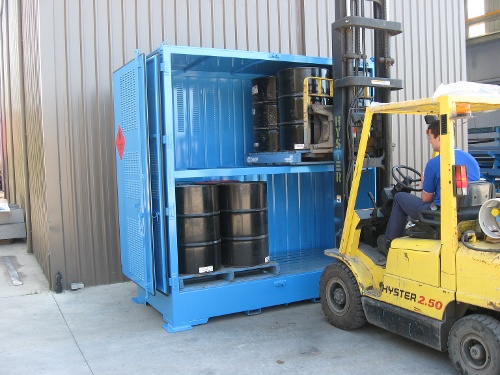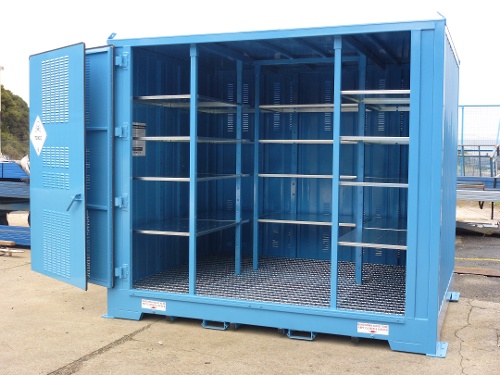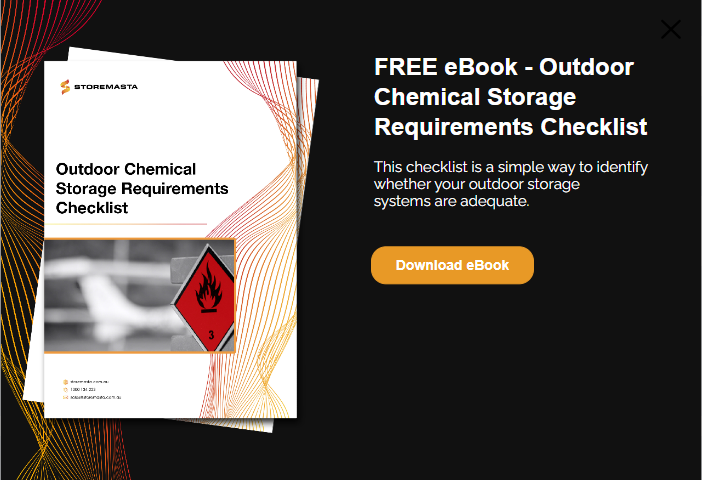So, you’ve recently purchased an outdoor chemical storage container to house your dangerous goods? That’s great to hear. But do you know the next steps that you’ll have to take to keep your chemical storage container compliant? In this blog, we’ll be detailing 5 key considerations for the installation, usage and maintenance of your new container. From choosing a safe outdoor location to ensuring your staff maintain the correct loading and stacking practices, our quick guide will help you keep your new DG container organised, safe and compliant.
1. Location
When choosing a location for your hazardous chemical storage container, there are a range of factors that you need to take into consideration. First and foremost, you need to choose a location that meets all your compliance obligations.
This includes, but is not limited to:
- Separation from protected/public places – depending on the type and quantity of chemical that you’re storing, you may have to locate your store away from protected and/or public places.
- Segregation from incompatible substances – you must not locate chemicals close to incompatible substances.
- Isolation from ignition sources – if your chemicals are flammable or explosive, you must ensure that all ignition sources are removed from the area.
- Away from emergency evacuation routes – it’s your legal responsibility to make sure that your chemical stores do not impede evacuation of your premises in the event of an emergency.
But there are also additional considerations that you will make that can help with the efficiency and security of your operations:
- Convenience – is your container located in a spot that offers easy access for staff or will they have to travel long distances to use or transfer the chemicals?
- Good use of outdoor space – most businesses require an economical use of space. When choosing your location, make sure it’s in a safe and convenient position, but not taking up unnecessary and valuable outdoor space.
- Not in direct sunlight – many classes of dangerous goods should not be kept in direct sunlight or extreme heat. Check the Safety Data Sheets (SDS) of your chemicals and position your container in a protected area. You may also have to consider the installation of an awning or sunshade over your chemical container.
- Protected from impact damage – in an outdoor environment, there is a greater chance of impact damage occurring to your chemical stores. Position your container in a location that is not in the path of vehicle or foot traffic. Also ensure that it’s not installed directly under overhanding trees and away from mezzanine levels or open balconies.
Consider how the location of your outdoor chemical store could reduce risk for your organisation.
2. Anchoring
The next step in installing your outdoor chemical storage container is to position it in a stable, level space — and anchor it firmly to the spot.
Anchoring your container provides extra stability in the outdoor environment, where high winds, fallen tree branches or even a rogue forklift could damage or topple the container.
Your storage container should be equipped with all the features necessary for anchoring it to the correct spot, including base plates which can be bolted down once you’re happy with the positioning of the container.
While anchoring your outdoor store is not a requirement of the Australian Standards, we highly recommend securing your container as it provides extra stability and safety in the outdoor environment.
3. Signage
If a visitor or contractor arrived at your site, would they know that your storage container was housing dangerous goods? Would your staff be aware of the potential hazards associated with the stored chemicals that you’re keeping onsite? Displaying the correct dangerous goods and hazard signage on your chemical stores is a legal requirement under WHS Regulations.
Your DG signage is in place to ensure that all the necessary precautions are taken by your staff, contractors and site visitors who may encounter these hazardous chemicals. Signage must include the dangerous goods diamond (such as Class 3 Flammable Liquids) as well as any other additional hazard signage that applies to your stored chemicals (such as No Ignition Sources Within 3 Metres).
In addition to your dangerous goods diamond and hazard signage, you should also ensure that your essential documents are secured to – or within easy reach of – your outdoor chemical store.
The documents that should always be made available to all staff and emergency services should include:
- SDS – the SDS of each stored chemical must be kept within reach of your chemical store. Choose a suitable document holder to keep these sheets secure and in good condition.
- Manifest Of Hazardous Chemicals – this is required if your organisation exceeds chemical threshold limits. It’s a complete list of every hazardous chemical that you have onsite. This should be kept in a clearly visible location, such as a HAZMAT box placed in a location close to the main entry of your site.
- Emergency Information – if a fire or chemical spill did occur in your organisation, your staff and emergency crews will need access to a site emergency plan. This can be kept in a HAZMAT box, along with your Manifest.
IMPORTANT: While a compliant chemical storage container will be equipped with signage, it’s your responsibility to make sure that the signage is always visible. You must also replace the signage as soon as any damage or wear and tear is identified.
4. Loading and Stacking
Outdoor chemical stores may be designed to house chemical containers, drums or IBCs. Whatever type of chemical package you’re storing, you’ll need to implement and oversee the correct loading and stacking practices for your store.
There are specific requirements in the relevant Australian Standard that relate to safe practices for loading and stacking hazardous chemicals. You should refer to the Standard that relates to your class of dangerous goods to make sure you’re loading and stacking the storage container in the correct way.
General rules include:
- Don’t overload - make sure that you never overload your storage container past the maximum capacity rating. You can find the rating on the front of the chemical store.
- Load suitable chemical packages – you should load your container with the chemical packages applicable to the storage container type, for example, don’t store smaller chemical containers in a store made for IBCs.
- Safe stacking – stacking multiple drums or IBCs may not be a compliant practice due to the instability of the stack. If you require more shelving to house your chemical packages, speak with your manufacturer or supplier about custom shelving options.

Maintaining the correct loading and stacking practices will reduce the risk of chemical spills and human harm.
5. Maintenance
To keep your DG container compliant, it’s important to establish a regular schedule
of housekeeping, inspections and maintenance. Day in, day out, there are many things that can occur which may negate the safety features of your storage container — and render it non-compliant.
The following considerations should be made when looking at maintaining your container:
- Spill containment system – the spill containment system in your bunded container should be cleaned out whenever leaks or spills occur.
- Correct chemical class - the correct dangerous goods class must be the only class of chemicals stored in the storage container. Check your SDS to ensure that there are no chemical incompatibilities in your storage area.
- Ventilation - Any louvres or natural ventilation system should be inspected and maintained to ensure they’re clean and free from residue.
- Security - Locking bars or security measures should remain in good working order, as this is a requirement of WHS Regulations.
- Shelving – ensure that all container shelving is clean and free from chemical residue. No containers should be placed in a position that prohibits the doors from closing.
- Usage – the correct loading and stacking practices should be established and monitored. Only fully trained staff should be using the chemical container.
- DG signage – all applicable signage must be visible and in good condition.
- Overall condition - the storage container must be inspected to ensure it has no scratches, dents or corrosion.
You must ensure that your DG container remains compliant by monitoring the installation, usage and overall condition of your new container.
Keeping Your Hazardous Chemical Storage Container Compliant
As we’ve detailed in this blog, there are a wide range of points to consider once you have purchased a hazardous chemical storage container. We’ve listed 5 key points — but there are many more to consider. Choosing the right location, anchoring your store and developing strict procedures for its usage and maintenance can all reduce risk in your chemical stores. But just like any type of DG store, it’s important that you always follow WHS Regulations, and refer to the Australian Standards for further detailed guidance on handling and storage practices.
To learn more about hazardous chemical storage in the outdoor environment, why not download our free checklist? Specifically created for organisations who are carrying flammable goods, this checklist will help you minimise the risk of fires, chemical injury and other hazards associated with dangerous goods storage. Grab your checklist for free today by clicking on the below image.
Joining the team as a Dangerous Goods Storage Consultant, Melissa Hampton became Storemasta's Marketing Manager in late 2021. With extensive knowledge and experience in chemical compliance, Melissa is responsible for leading the Marketing team and helping shape their marketing strategy. In her spare time, you can find Melissa hiking, swimming and enjoying the great outdoors in beautiful north-west Tasmania.

/How%20to%20store%20hazardous%20chemicals%20legally%20and%20safely-703474-edited.jpg?width=500&name=How%20to%20store%20hazardous%20chemicals%20legally%20and%20safely-703474-edited.jpg)
